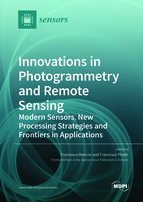Innovations in Photogrammetry and Remote Sensing: Modern Sensors, New Processing Strategies and Frontiers in Applications
A special issue of Sensors (ISSN 1424-8220). This special issue belongs to the section "Remote Sensors".
Deadline for manuscript submissions: closed (10 February 2022) | Viewed by 31035
Special Issue Editors
Interests: laser scanning; remote sensing; machine learning; geomatics engineering; photogrammetry
Special Issues, Collections and Topics in MDPI journals
Interests: geomatics engineering; photogrammetry; remote sensing; surveying; spatial analysis
Special Issues, Collections and Topics in MDPI journals
Special Issue Information
Dear Colleagues,
The Special Issue aims for papers showing the progress made in key areas of photogrammetry and remote sensing. Papers focused on modern and/or forthcoming sensors, improvements in data processing strategies, and assessment of their reliability are welcome for the Special Issue. Additionally, the Special Issue aims to collect papers devoted to the application of such innovations as proof of the contribution offered in the observation of the natural and built environment and understanding of phenomena at required spatial scale. In particular, the following topics can be addressed in proposed submissions:
- Forthcoming sensors in photogrammetry and remote sensing
- Quality Assurance / Quality Control (QA/QC)
- Potentialities offered by multi-sensors data fusion
- Methodologies for near real-time mapping and monitoring from aerial/satellite platforms
- Big dataset handling
- Artificial Intelligence for data processing
- 3D modelling
- Error budget
- Novel approaches for processing of multi-temporal data
- Design, testing and applications of new sensors
Prof. Francesco Mancini
Prof. Francesco Pirotti
Guest Editors
Manuscript Submission Information
Manuscripts should be submitted online at www.mdpi.com by registering and logging in to this website. Once you are registered, click here to go to the submission form. Manuscripts can be submitted until the deadline. All submissions that pass pre-check are peer-reviewed. Accepted papers will be published continuously in the journal (as soon as accepted) and will be listed together on the special issue website. Research articles, review articles as well as short communications are invited. For planned papers, a title and short abstract (about 100 words) can be sent to the Editorial Office for announcement on this website.
Submitted manuscripts should not have been published previously, nor be under consideration for publication elsewhere (except conference proceedings papers). All manuscripts are thoroughly refereed through a single-blind peer-review process. A guide for authors and other relevant information for submission of manuscripts is available on the Instructions for Authors page. Sensors is an international peer-reviewed open access semimonthly journal published by MDPI.
Please visit the Instructions for Authors page before submitting a manuscript. The Article Processing Charge (APC) for publication in this open access journal is 2600 CHF (Swiss Francs). Submitted papers should be well formatted and use good English. Authors may use MDPI's English editing service prior to publication or during author revisions.
Keywords
- Photogrammetry
- Remote sensing
- Innovative sensors
- Multi-sensor data fusion
- Artificial Intelligence for data processing
- 3D modelling
- Error budget
- Earth observation








